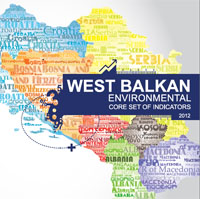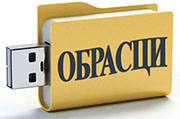| EXCEEDANCE OF AIR QUALITY LIMIT VALUES IN URBAN AREAS – PM10 |
The indicator shows the portion of urban population potentially exposed at ambient air concentrations of pollutants in excess of the limit value set for human health protection.
Urban population taken into account is actually the total number of inhabitants living in cities with at least one monitoring station. These cities include the capital and other major cities of the Republic of Macedonia. The number of inhabitants is based on the last census carried out by the State Statistical Office in 2002.
Exceedance of air quality limit values occurs when the concentration of air pollutants exceeds the limit values for SO2, PM10, NO2 and the target values for O3 as specified in the Decree on the limit values of levels and types of polluting substances in ambient air and on the alert thresholds, deadlines for the limit values achievement, margins of limit value tolerance, target values and long-term ozone targets (Official Gazette of the Republic of Macedonia No. 50/05, 4/2013), wherein the requirements of the Directive on Ambient Air Quality and Cleaner Air in Europe 2008/50 EC and Heavy Metals Directive 2004/107/EC have been transposed. Where there are multiple limit values (see section on Policy Targets), the indicator uses the most stringent case:
- Sulphur dioxide (SO2): the daily mean limit value
- Nitrogen dioxide (NO2): the annual limit value
- Particulate matter of a size up to 10 micrometer (PM10): the daily mean limit value
- Ozone (O3 ): the short term objective
The percentage of urban population potentially exposed at ambient air concentrations of sulphur dioxide (SO2), particulate matter sized up to 10 micrometer (PM10), nitrogen dioxide (NO2) and ozone (O3) above limit values set for human health protection. Ambient air concentrations of sulphur dioxide (SO2), particulate matter sized up to 10 micrometer (PM10), nitrogen dioxide (NO2) and ozone (O3) are expressed in microgram/m3(µg/m3).
What progress has been achieved in reducing the concentrations of pollutants in urban areas in order to achieve the limit values for PM10 set in the Decree?
In the period from 2004 to 2017, 100% of the population has been exposed at concentrations of suspended particulate matter in excess of the limit values specified in the Decree. Significantly higher concentrations of PM10 are measured during winter period.
Diagram 1: Percentage of urban population exposed at air pollution in areas where concentrations of pollutants are in excess of limit/target values
Diagram 2: Percentage of urban population exposed at concentrations of РМ10 above the daily mean limit value, expressed as number of days in the course of a calendar year
Diagram 3: 36th highest mean daily concentration of PM10
Data coverage: excel
Source: Ministry of Environment and Physical Planning (https://arhiva.moepp.gov.mk/?lang=en)
Suspended particulate matters of size up to 10 micrometers are particles able to pass through an opening conducting selection by size, with 50% loss in efficiency at aerodynamic diameter of size less than ten micrometers (10 μm). These particles of size not exceeding 10 micrometers are the so called fine particles or aerosols. Their retention time in the air is long and they originate from natural and anthropogenic sources. Among natural sources, the more prominent include yellow rains, present also with us, forest fires and chemical reactions going on in nature. Combustion of coal, wood and oil, industrial processes, transport and waste burning are the most significant anthropogenic sources.
Increased concentrations of suspended particulate matters can be recorded in urban areas, especially in autumn-winter seasons, which is most probably due to increased frequency in traffic, fossil fuels combustion and meteorological conditions.
The processed data for the period 2004 to 2017 show that during the entire period, 100% of the population was exposed at concentrations of suspended particulate matters are in excess of the limit value (mean daily limit value of 50 µg/m3that shall not be exceeded in more than 35 days in the course of a calendar year). 100% of the population was exposed at concentrations above the limit value in more than 35 days in a calendar year.
- Methodology for the indicator calculation
For each urban measuring station, the number of days with daily mean concentration above the limit value (daily mean limit value is 50 µg/m3) is calculated from the available hourly data. Selected urban stations include stations of the following types: stations measuring traffic pollution, stations measuring industrial pollution and urban background stations. The number of days with exceedance in a city is obtained by averaging the mean values of the results from all stations located in that city.
Uncertainty
- Methodological uncertainty and data uncertainty
In general, data is not representative for all urban environments in the Republic of Macedonia. Compared to the methodology of the European Environmental Agency, where the calculation of the indicator is based only on data produced by the urban background stations, in our calculations we used data from all measuring stations located in urban environments. Also, due to the minimum number of monitoring stations, the calculation of the indicator also took into account the stations where data coverage is below 75% per calendar year. We can also point out as uncertainty in the indicator calculation the fact that the number of inhabitants in cities is based on the census of the population conducted by the State Statistical Office in 2002, instead of estimated number of population for each year.
List of relevant policy documents
The National Plan for Air Protection presents the state of air quality, defines the measures for ambient air quality protection and improvement in the Republic of Macedonia and all relevant institutions responsible for their implementation within 5 year period, namely from 2013 to 2018 (Official Gazette of the Republic of Macedonia no.170/2012).
Legal grounds
The Law on Ambient Air Quality was adopted in August 2004 and later amended on several occasions in line with the requirements of the relevant EU legislation (Official Gazette of the Republic of Macedonia Nos. 67/2004, 92/2007, 83/2009, 35/2010, 47/2011, 59/2012, 163/13, 10/15 and 146/15) and it is framework law in the area of air. The main goals of this Law are: avoidance, prevention and reduction of harmful effects on human health and environment as a whole, prevention and reduction of pollution resulting in climate change, as well as provision of the relevant information on the quality of ambient air. This Law establishes the legal grounds for adoption of a number of bylaws in line with the requirements of the relevant Acquis Communitaire. So far, 12 bylaws have been adopted. Calculations for this indicator are based on the provisions of the Decree on the limit values of levels and types of polluting substances in ambient air and on the alert thresholds, deadlines for the limit values achievement, margins of limit value tolerance, target values and long-term ozone targets (Official Gazette of the Republic of Macedonia No. 50/05, 4/2013 and 183/2017).
The Decree on the limit values of levels and types of polluting substances in ambient air and on the alert thresholds, deadlines for the limit values achievement, margins of limit value tolerance, target values and long-term targets, defines the limit values for SO2, PM10, NO2 and target values for O3.
Limit values for concentrations of suspended particulate matter of size up to 10 micrometers in the ambient air
The said Decree specifies two limit values for suspended particulate matter of size up to 10 micrometers, for the purpose of human health protection.
- 24-hourly limit value is 50 μg/m3,and it shall not be exceeded by more than 35 times during one calendar year
- The mean annual concentration shall not exceed 40 μg/m3.
European Environmental Agency
- Air quality data exchange in accordance with implementing Decision containing the rules of Directives 2004/10/EC and 2008/50/EC of the European Parliament and of the Council concerning reciprocal exchange of information I reporting on ambient air quality (Decision 2011/850/EC).
| Code | Title of the indicator | Compliance with CSI ЕЕА or other indicators | Classification by DPSIR | Type | Linkage with area | Frequency of publication | |
| MKNI 004 | Exceedance of air quality limit values in urban areas | CSI 004 | Exceedance of air quality limit values in urban areas | S | А | air
Air quality |
annual |








































































